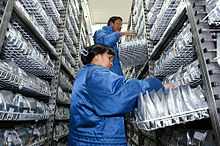International Rice Research Institute
 | |
| Motto | "Rice Science For A Better World" |
|---|---|
| Formation | 1960 |
| Type | Non-profit research and training center |
| Purpose | Research |
| Headquarters | Los Baños, Laguna |
| Location | |
Region served | Worldwide |
Director General | Dr. Robert S. Zeigler |
Main organ | Board of Trustees |
Parent organization | Consultative Group on International Agricultural Research |
Budget | US$93.52 million (2013)[1] |
Staff | 1,300[2] |
| Website | www.irri.org |
The International Rice Research Institute (IRRI) is an international research and training organization with headquarters in Los Baños, Laguna in the Philippines and offices in sixteen countries.[3][4] The non-governmental organization (NGO) was established in 1960 to develop new rice varieties and rice crop management techniques with finding sustainable ways to improve the well-being of poor rice farmers and consumers as well as the environment in mind.
The institute is one of 15 agricultural research centers on the world that form CGIAR. It is also the largest non-profit agricultural research center in Asia.[5]
IRRI received the 2010 BBVA Foundation Frontiers of Knowledge Award in the category of Development Cooperation.
Origins
IRRI was established in 1960 with the support of the Ford Foundation, Rockefeller Foundation and the Government of the Philippines.[6]
Impact

IRRI is well known for its contribution to the "Green Revolution" movement in Asia during the late 1960s and 1970s, which involved the breeding of "semidwarf" varieties of rice that were less likely to lodge (fall over). The varieties developed at IRRI, known as IR varieties, are well accepted in many Asian countries. In 2005, it was estimated that 60% of the world's rice area was planted to IRRI-bred rice varieties or their progenies.[7]
A report published by the Australian Centre for International Agricultural Research in 2011 assessed the impact of IRRI's breeding work in three countries in South East Asia between 1985 and 2009. It found IRRI's breeding work delivered an annual benefit of US$1.46 billion and boosted rice yields up to 13%.[8]
Research

IRRI's current scope of research covers:[9]
- Conserving, understanding, sharing, and using rice genetic diversity
- Breeding and delivering new varieties of rice
- Developing and sharing improved crop and environment management practices
- Adding value to the economic and nutritional value of rice
- Broadening our impact by supporting strategic policy and market development
- Facilitating large-scale adoption of rice technologies
In 2010, the Global Rice Science Partnership (GRiSP) was launched, which IRRI leads in Asia, the Africa Rice Center (AfricaRice) leads in Africa, and International Center for Tropical Agriculture (CIAT) leads in Latin America. It aims to "dramatically improve the ability of rice farmers to feed growing populations in some of the world’s poorest nations".[10]
Facilities

IRRI's headquarters in the Philippines is located on a 252 hectares (620 acres) experimental farm with modern laboratories and glasshouses, and a training center. The land is owned by the University of the Philippines and is leased to the institute. It also houses the International Rice Genebank and Riceworld Museum.
See also
- Banaue Rice Terraces
- Green Revolution
- Irrigated Rice Research Consortium
- Rice paddy
- Rockefeller Foundation
References
- ↑ "IRRI website: Funding and donors".
- ↑ "IRRI website: Our people".
- ↑ "IRRI website: About IRRI".
- ↑ "International Rice Research Institute on Google maps".
- ↑ "International Rice Research Institute celebrates its 50th Anniversary". Manila Bulletin (Manila Bulletin Publishing Corp.). 2009-12-09. Retrieved 2010-05-31.
- ↑ "An adventure in applied science: A history of the International Rice Research Institute".
- ↑ "IR varieties and their impact".
- ↑ "ACIAR report: International Rice Research Institute’s contribution to rice varietal yield improvement in South-East Asia".
- ↑ "IRRI website: Our work".
- ↑ "Media release: Improved rice availability and reduced environmental impact forecast through new Global Rice Science Partnership" (Press release). Cgia.org.
External links
| Wikimedia Commons has media related to International Rice Research Institute. |
- Official website
- Global Rice Science Partnership
- Annual Reports
- Downloadable (free) books published by the International Rice Research Institute
- Important Dates in IRRI History, 1960-2011
- Rice Today magazine
| ||||||